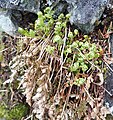
Botrypus virginianus, synonym Botrychium virginianum, sometimes called rattlesnake fern is a species of perennial fern in the adders-tongue family. It is monotypic within the genus Botrypus, meaning that it is the only species within the genus. It is called the rattlesnake fern in some parts of North America, due to its habit of growing in places where rattlesnakes are also found. Rattlesnake fern prefers to grow in rich, moist woods in dense shade and will not tolerate direct sunlight.
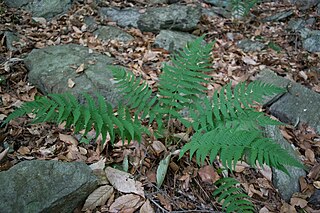
Dryopteris marginalis, vernacularly known as the marginal shield fern or marginal wood fern, is a perennial species of fern found in damp shady areas throughout eastern North America, from Texas to Minnesota and Newfoundland. It favors moderately acid to circumneutral soils in cooler areas but is fairly drought-resistant once established. In the warmer parts of its range, it is most likely to be found on north-facing non-calcareous rock faces. It is common in many altitudes throughout its range, from high ledges to rocky slopes and stream banks. Marginal wood fern's name derives from the fact that the sori are located on the margins, or edges of the leaflets.

Polystichum acrostichoides, commonly denominated Christmas fern, is a perennial, evergreen fern native to eastern North America, from Nova Scotia west to Minnesota and south to Florida and eastern Texas. It is one of the most common ferns in eastern North America, being found in moist and shady habitats in woodlands, stream banks and rocky slopes. The common name derives from the evergreen fronds, which are often still green at Christmas.
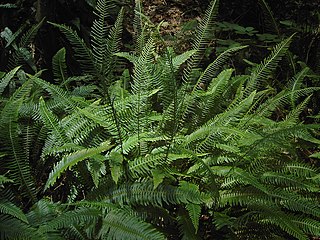
Struthiopteris spicant, syn. Blechnum spicant, is a species of fern in the family Blechnaceae, known by the common names hard-fern or deer fern. It is native to Europe, western Asia, northern Africa, and western North America. Like some other species in the family Blechnaceae, it has two types of leaves. The sterile leaves have flat, wavy-margined leaflets 5 to 8 millimeters wide, while the fertile leaves have much narrower leaflets, each with two thick rows of sori on the underside.

Cryptogramma is a genus of ferns known commonly as rockbrakes or parsley ferns. They are one of the three genera in the Cryptogrammoideae subfamily of the Pteridaceae. Cryptogramma ferns can be found in temperate regions on several continents worldwide. These ferns have two kinds of leaves which often look so different that at first glance they appear to belong to different plants. The fertile leaves have long, narrow, bumpy segments with undersides covered thickly in sporangia. The edges of the segments may curl back to cover the sporangia, forming a false indusium. The sterile leaves have thinner, wider segments which may be rounded and resemble the leaves of parsley. These ferns grow in rocky areas, often in crevices and cracks.

Sceptridium multifidum is a fern species in the Ophioglossaceae, known by the common names leathery grapefern and leathery moonwort.

Aspidotis densa is a species of fern in the Cheilanthoid subfamily, known by the common name Indian's dream or Serpentine fern or dense lace fern. It is native to the west coast of North America from British Columbia to California and east to the Rocky Mountains in Idaho, Montana, and Wyoming; there is a disjunct population on serpentine soils in Quebec.

Asplenium septentrionale is a species of fern known by the common names northern spleenwort and forked spleenwort. It is native to Europe, Asia and western North America, where it grows on rocks. Its long, slender leaves give it a distinctive appearance. Three subspecies exist, corresponding to a tetraploid and a diploid cytotype and their triploid hybrid.

Botrychium ascendens is a species of fern in the family Ophioglossaceae known by the common names triangle-lobe moonwort and upswept moonwort. It is native to North America from British Columbia to northern California as well as parts of eastern Canada. It lives in different habitat types, including grassy riverside areas. This is very small plant growing from an underground caudex and sending one yellow-green leaf above the surface of the ground. The leaf is up to 6 centimeters tall and is divided into a sterile and a fertile part. The sterile part of the leaf has fan-shaped or wedge-shaped leaflets. The fertile part of the leaf is very different in shape, with tiny grapelike clusters of sporangia by which it reproduces.

Botrychium crenulatum is a species of fern in the family Ophioglossaceae known by the common names scalloped moonwort and dainty moonwort. It is native to North America from British Columbia to California to Wyoming, where it is uncommon throughout most of its range, appearing incidentally at scattered spots on wet meadows in coniferous forests and marshy areas such as swamps. This is very small plant growing from an underground caudex and sending one thin, shiny, yellow-green leaf above the surface of the ground. The leaf is up to about 6 centimeters tall and is divided into a sterile and a fertile part. The sterile part of the leaf has veined, fan-shaped leaflets with wrinkly edges. The fertile part of the leaf is very different in shape, with tiny grapelike clusters of sporangia by which it reproduces.

Botrychium minganense is a species of fern in the family Ophioglossaceae known by the common name Mingan moonwort. It is native to North America from Alaska and northern Canada to Arizona, where it is uncommon throughout most of its range, appearing at scattered spots in coniferous forests and marshy areas such as swamps.

Botrychium montanum is a species of fern in the family Ophioglossaceae known by the common names western goblin and mountain moonwort. It is native to western North America from British Columbia to northern California to Montana, where it grows in the dark understory of coniferous forests and other moist wooded areas. This very small plant grows from an underground caudex sending one thin gray-green leaf above the surface of the ground. The leaf is less than 8 centimeters tall and is divided into a sterile and a fertile part. The sterile part of the leaf has irregularly shaped angled leaflets. The fertile part of the leaf is very different in shape, with grapelike clusters of sporangia by which it reproduces.

Botrychium pinnatum is a species of fern in the family Ophioglossaceae, known by the common name northwestern moonwort. It is native to North America from Alaska to northern Canada to California and Arizona, where it is generally scattered and uncommon, growing in coniferous forests and grassy meadows. This is very small plant growing from an underground caudex and sending one thin, shiny, green leaf above the surface of the ground. The leaf is less than 8 centimeters tall and is divided into a sterile and a fertile part. The flat sterile part of the leaf has oval to widely lance-shaped leaflets. The fertile part of the leaf is very different in shape, with grapelike clusters of sporangia by which it reproduces.
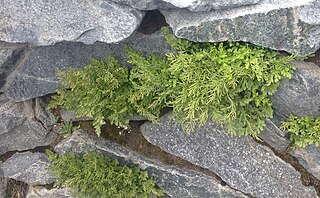
Cryptogramma cascadensis is a species of fern known by the common names Cascade parsley fern and Cascade rockbrake.

Amauropelta noveboracensis, the New York fern, is a perennial species of fern found throughout the eastern United States and Canada, from Louisiana to Newfoundland, but most concentrated within Appalachia and the Atlantic Northeast. New York ferns often forms spreading colonies within the forests they inhabit.

Pellaea truncata is a species of fern known by the common name spiny cliffbrake. It is native to the southwestern United States and northern Mexico, where it grows in rocky areas, such as cliffs and slopes.

Deparia acrostichoides, commonly called silvery glade fern or silvery spleenwort, is a perennial species of fern. Its range includes much of the eastern United States and Canada, from Ontario to Nova Scotia and Georgia to Louisiana, as well as eastern Asia in China, Russia, Japan and Korea. The name silvery comes from the fact that the indusia on the underside of the leaf have a silver color when the sori are close to ripening.
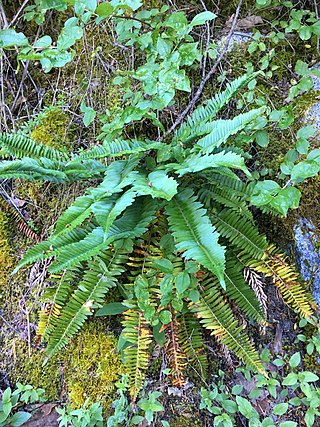
Polystichum imbricans is a species of fern known by the common names narrowleaf swordfern and imbricate sword fern. It is native to western North America from British Columbia and Idaho to southern California, where it grows in rocky soil and cracks in rock outcrops in coastal and inland mountain ranges and foothills.

Polystichum scopulinum is a species of fern known by the common names mountain hollyfern and rock sword fern. It is native to much of western North America, and it is known from disjunct occurrences in eastern Canada as well. It grows in rocky habitat, often in full sun. It is widespread but mostly found in small populations, and is noted to be most abundant on serpentine soils. This fern produces several erect, narrowly lance-shaped leaves up to 50 centimeters in length. The leaves narrow near the bases. Each leaf is divided into many lance-shaped or oblong leaflets up to 3 centimeters long. The toothed leaflets are sometimes twisted on their axes and overlapping.
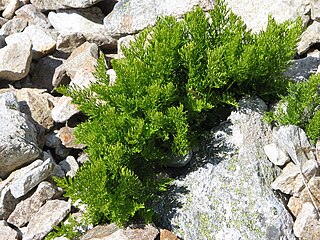
Cryptogramma crispa, the parsley fern, is an Arctic–alpine species of fern. It produces separate sterile and fertile fronds, up to 30 cm (12 in) tall, and is a pioneer species on acidic screes.


